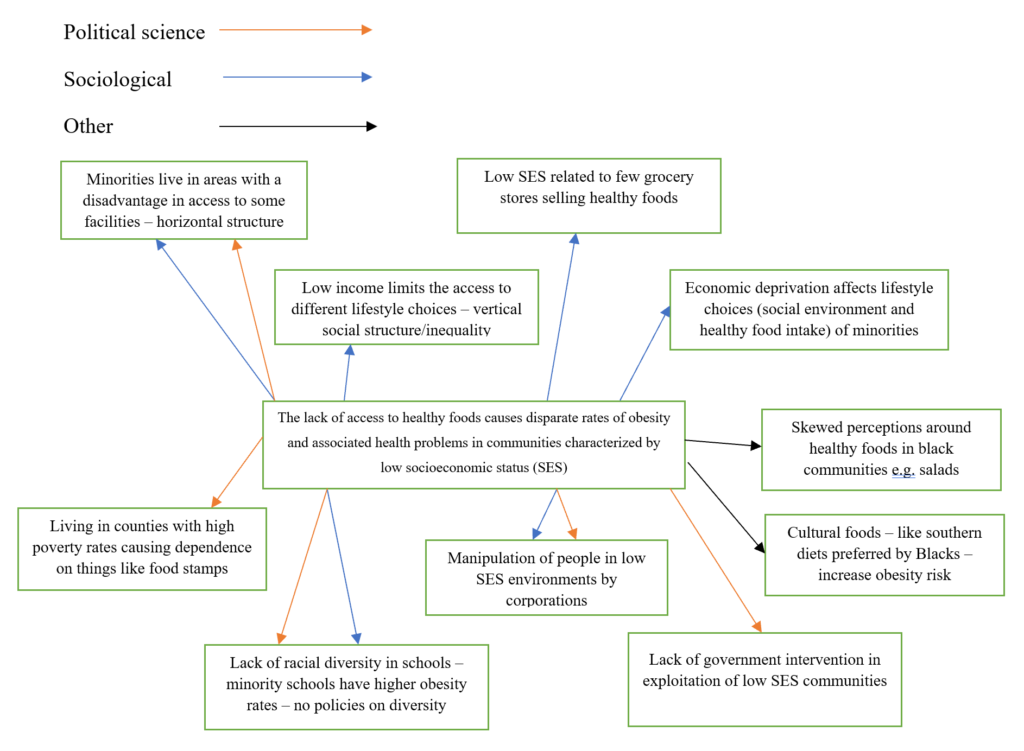The lack of access to healthy foods causes disparate rates of obesity and associated health problems in communities characterized by low socioeconomic status. (ISS4304 – Contemporary social problems).
June 14, 2021 2021-06-16 9:11The lack of access to healthy foods causes disparate rates of obesity and associated health problems in communities characterized by low socioeconomic status. (ISS4304 – Contemporary social problems).

The lack of access to healthy foods causes disparate rates of obesity and associated health problems in communities characterized by low socioeconomic status. (ISS4304 – Contemporary social problems).
Introduction
This paper explores the case of how lack of access to healthy foods causes disparate rates of obesity and associated health problems in communities characterized by low socioeconomic status (SES). The paper bases its arguments on sociological and political science perspectives of the obesity problem in communities of low SES. Under the sociological perspective, the general argument in that minority and marginalized groups, by the virtue of living different lifestyles based on varying socioenvironmental factors have disadvantaged access and relationships with healthy foods. The political science perspective on the other hand is used to argue that corporate manipulation, government policy inaction, and problematic policies such as on school compositions lead to poor access to healthy foods by individuals in low SES areas and communities.
Part 1: Map of Interdisciplinary connections
The map below shows the perspectives of the problem drawn from both the sociological and political science perspectives.

Part 2: Understanding the problem
Sociology
The social environment can determine the extent of access to facilities and can also potentially limit lifestyle choices. Wen and Kowaleski-Jones (2012) found that racial-ethnic and income disparities existed in their analysis of built environment of neighbourhoods and how this influenced obesity levels. Findings showed that White neighbourhoods had high income levels and were generally well-planned offering incentives such as walking to work. However, Wen and Kowaleski-Jones (2012) also found that while Blacks had better access to amenities such as parks, this did not improve on their obesity levels. This could imply that their social context could be affecting their obesity levels. Using the horizontal social structure, it is evident that by living in communities that are not diverse, minorities have limited choices of lifestyle compared to their White counterparts. Similarly, the vertical social structures are different as Wen and Kowaleski-Jones (2012) found that Whites tend to live in socioeconomically advantaged suburban areas with work premises for example being at walking distance.
Yu et al, (2017) shows how access if for instance limited in the case of grocery stores. In their findings, Yu et al, (2017) establish that Blacks were at a higher risk of obesity due to lack of large grocery outlets – which normally stock healthy foodstuff – in their locations. Also, Blacks were found to live in areas with concentrated disadvantages – having low average income – that resulted in limited choices of food. Evidently, their lifestyle choices, as was the interpretation on the findings by Wen and Kowaleski-Jones (2012), are defined by their social environment and backgrounds. Both Wen and Kowaleski-Jones (2012) and Yu et al, (2017) highlight the fact that Blacks – and minorities – live in low-income urban areas in an isolated format – non-diverse – that puts them at a socioeconomic disadvantage which included limited lifestyle options.
Political Science
The study by Powell (2016) elaborates on how lack of governing policies protecting consumers could lead to exploitation of these consumer groups by corporations. The specific case in reference is that of food and drink brands posing as if providing solutions to the problem of unhealthy consumption make children lifelong consumers of unhealthy food hence causing obesity. The power balance between corporations and consumers is skewed and this is evident in the fact that children and their teachers saw nothing inherently wrong with the actions of the corporations. Such a case besides showing how lack of access to power by low SES communities can further their manipulation, indicates how lack of government intervention – for public interest – can also extend the exploitation.
Need a paper like this one? Order here – https://prolifictutors.com/place-order/
Piontak and Schulman (2016) on the other hand points at systematic issues in governance that cause children of colour to be at a 3% higher risk of obesity for living in concentrated poverty and racially segregated schools. Without the government working for the interest of such groups, such as expanding school diversity and solving poverty issues, the children have limited choices including on healthy diet. Piontak and Schulman (2016) highlights this with the finding on rural school children being in families that rely on food stamps.
Part 3: Integration of Interdisciplinary perspective
Lack of access to healthy foods can be explained from both a sociology and political science perspective. In isolation, each of these disciplines have strong arguments. For example, in sociology, neighborhood characteristics including access to things like grocery stores can cause obesity in disparate rates between races (Ye et. al, 2017). In political science, lack of government intervention through policy can render some groups at a socioeconomic disadvantage and hence expose them to obesity. Such is the case of food and drink corporations preying on child customers and using their corporate powers to manipulate consumption to their favor (Powell, 2016). An interdisciplinary analysis combines these perspectives into a more elaborate understanding of the problem. In this case, as sociology explains the problems associated with minorities for instance living together in a socially disadvantaged state that denies them access to healthy food, political science adds in the role of policy and governance into the explanation.
Inaccessibility is a function of governance. As evidenced by Piontak and Schulman (2016) higher obesity rates were witnessed in racially segregated schools with concentrated poverty and including those in rural areas. The government’s failure to solve poverty and offer diversity rules or quotas in schools has directly caused the issues identified by Piontak and Schulman (2016). This political science view is mirrored in the sociological perspective of limited choice of lifestyle based on horizontal and vertical social structures. Living in socioeconomically disadvantaged areas as shown in the outcomes by Yu et al (2017) results in lack of access to grocery stores with healthy food options. This inaccessibility of grocery stores based on social factors of the residents – race and ethnicity – is comparable to how children in racially segregated primary schools in rural areas have to depend on food stamps. In both cases, the low SES are denied choice or access by circumstances and it is only that one perspective of the problem points at the government’s failure and the other looks at social factors plaguing the lifestyle context.
An additional example is that for school children and their teachers, where despite being the primary role of the government, education has been relegated into being at the mercy of big corporations and their interests. Powell’s (2016) findings where children are manipulated into being life long consumers of unhealthy diets is an example of this case. Political science explains this through the demonstrated negligence on the government’s part given that policies and laws are the main ways a government can protect and uplift low SES communities. In reference to this same case, sociological perspective would be that the children are at the mercy of their unfortunate circumstances – social structures. This argument could be borrowed from the sociological perspective applied on the findings by Wen and Kowaleski-Jones (2012) where built environment of the community when mediated by socioeconomic status of residents determines the obesity levels.
Need a paper like this one? Order here – https://prolifictutors.com/place-order/
A singular dimension of view of the social problem – lack of access to healthy food – could thus be limited in the extent to which it creates understanding. For example, while sociology can describe the context of environmental factors leading to lack of access to a grocery store, and hence healthy food options Yu et al (2017), it cannot effectively explain how the social environment came into being. Similarly, political science can expound on the role of governance in uplifting the social environment such as through diversity in racially segregated schools and programs to end poverty (Piontak and Schulman, 2016). It may not however tie together all the socioeconomic factors that shape the lifestyle choices of low SES communities.
Conclusion
The discussion above on how the lack of access to healthy food causes disparate rates of obesity and associated health problems in communities characterized by low socioeconomic status can be solved via political science and sociological views. From a political science perspective, creating policies for instance that target racial segregation in schools and communities, and those that aid in poverty eradication could allow low SES individuals access healthy food. Using the sociological perspective, the inaccessibility of healthy food can be understood from social structure factors like built environment, concentration of poverty, and racial-ethnic compositions. As such, addressing problems within a particular race such as unemployment among Black households could improve their access to healthy food and consequently eliminate the disparity in obesity rates when compared to other races.
References
Barkan, S. E. (2001). Criminology: A sociological understanding. Prentice-Hall.
Piontak, J. R., & Schulman, M. D. (2016). School Context Matters: The Impacts of Concentrated Poverty and Racial Segregation on Childhood Obesity*. Journal of School Health, 86(12), 864-872.
Powell, D. (2016). Governing the (un)healthy child-consumer in the age of the childhood obesity crisis. Sport, Education and Society, 23(4), 297-310.
Wen, M., & Kowaleski-Jones, L. (2012). The built environment and risk of obesity in the United States: Racial–ethnic disparities. Health & Place, 18(6), 1314-1322. doi:10.1016/j.healthplace.2012.09.002 Behavior, 57(1), 1-21.
Yu, Q., Scribner, R. A., Leonardi, C., Zhang, L., Park, C., Chen, L., & Simonsen, N. R. (2017). Exploring racial disparity in obesity: A mediation analysis considering geo-coded environmental factors. Spatial and Spatio-temporal Epidemiology, 21, 13-23. doi:10.1016/j.sste.2017.02.001.
Need a paper like this one? Order here – https://prolifictutors.com/place-order/

![[Solved] ENGL147N - Week 7 Assignment- Final Draft of the Argument Research Paper](https://prolifictutors.com/wp-content/uploads/2023/01/Solved-ENGL147N-Week-7-Assignment-Final-Draft-of-the-Argument-Research-Paper--240x142.png)
![[Solution] - NR305 - Week 3 Discussion: Debriefing of the Week 2 iHuman Wellness Assignment (Graded](https://prolifictutors.com/wp-content/uploads/2022/06/Best-Answer-NR305-Week-3-Discussion-Debriefing-of-the-Week-2-iHuman-Wellness-Assignment-Graded--240x142.png)

![[Best Answer] NR305 - Week 2 Discussion: Reflection on the Nurse’s Role in Health Assessment (Graded)](https://prolifictutors.com/wp-content/uploads/2022/06/Best-Answer-NR305-Week-2-Discussion-Reflection-on-the-Nurses-Role-in-Health-Assessment-Graded-240x142.png)
![[Best Answer] NR305 - Week 2 Assignment: Wellness Assessment: Luciana Gonzalez (iHuman) (Graded)](https://prolifictutors.com/wp-content/uploads/2022/06/Best-Answer-NR305-Week-2-Assignment-Wellness-Assessment-Luciana-Gonzalez-iHuman-Graded--240x142.png)

